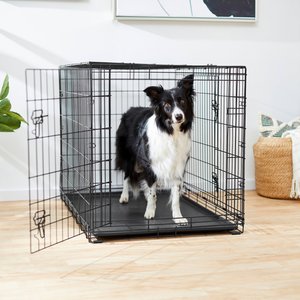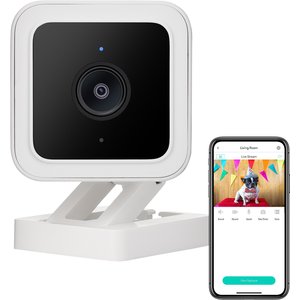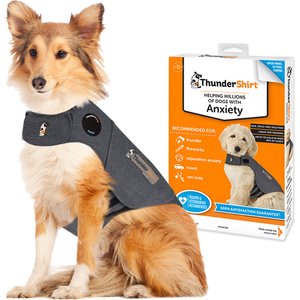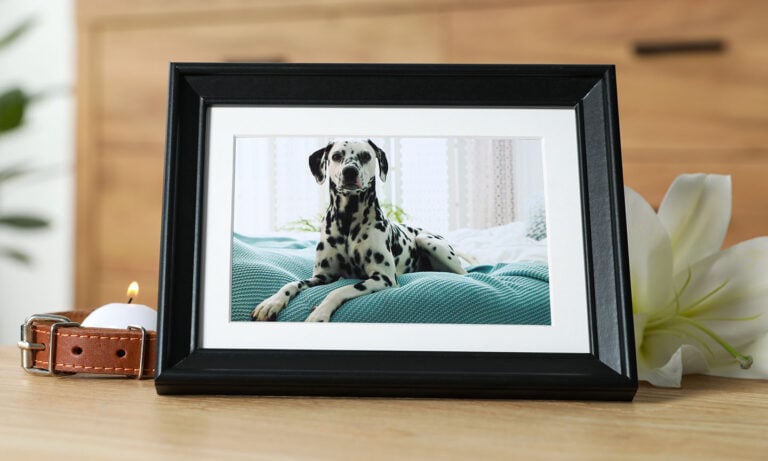For many pet parents, their dogs act as their fuzzy, four-legged shadows, always wanting to be by their sides. But when your dog’s attachment becomes so intense that your absence becomes unbearable for them, it can lead to genuine challenges, impacting both your lovable sidekick and you.
Dog separation anxiety is one of many types of dog anxiety. While it’s quite common, it’s also a serious condition that warrants immediate treatment.
Ahead, learn the signs and causes of this issue and how to help a dog with separation anxiety.
In This Guide:
What Is Dog Separation Anxiety?
Dog separation anxiety is the condition in which a dog responds to their pet parents’ absence with anxious episodes.
Yes, it’s common for dogs to whine or fuss a bit when you’re leaving the house without them—they don’t want to be left out! But a true anxious episode might persist the entire time you’re gone and could have harmful physical and mental effects on your dog.
What Causes Dog Separation Anxiety?
Dogs can develop separation anxiety for many reasons, many of which are related to changes in the dog’s life.
Causes of dog separation anxiety include:
- Family changes, such as when a family member moves out of the home or adds a new addition such as a new baby or roommate
- Home changes, such as when a dog is rehomed or moves with their family to a new home (even remodeling or reconstruction can cause issues)
- Routine changes, such as when a pet parent starts a new job with longer hours or transitions from a remote in-home job to an in-office role
Some dogs respond to changes like these with relatively little anxiety. For others, separation anxiety rears its stressed-out head. No one knows for sure why some dogs are more susceptible to separation anxiety than others. Even dogs who’ve been raised in supportive homes with plenty of attention and positive reinforcement can be affected—so don’t blame yourself!
Symptoms of Separation Anxiety in Dogs
So, how do you know if your dog is suffering? Because every dog is unique, separation anxiety will look different from pup to pup.
But if you’re noticing these common dog anxiety symptoms, there’s a good chance it’s time to take action:
- Destructive behaviors, like chewing or clawing at doors or walls
- Potty accidents, especially ones that happen only when you’re away in an otherwise fully potty-trained pup
- Vocalization, such as whining and barking
- Drooling, especially when it only happens when you’re gone
- Pacing, aka walking back and forth restlessly
Trembling, panting, lip-licking and yawning can all indicate that your dog may be feeling anxious.
Learn more about dog anxiety.
Mild vs. Severe Separation Anxiety in Dogs
The distinction between mild and severe separation anxiety primarily revolves around the intensity of symptoms and behaviors exhibited. Here's a breakdown of the differences.
Mild Separation Anxiety
Signs of mild separation anxiety in dogs might include:
- Occasional or light whimpering or whining
- Mild pacing or seeming slightly agitated
- Slight changes in appetite
- Light drooling
- Occasional indoor urination or defecation, despite being house trained
Severe Separation Anxiety
Signs of severe separation anxiety might include:
- Intense vocalization, including incessant barking, howling, or whining the entire time the pet parent is gone
- Destructive behaviors, such as chewing on furniture or self-mutilation
- Relentless pacing in a fixed pattern
- Excessive salivation
- Trying to escape confined areas
- Consistent potty accidents every time they’re left alone, even if they’re house trained
- Refusal to eat or drink when left alone
The severity of the anxiety often dictates the treatment approach, with milder forms benefiting from basic behavioral interventions, and severe forms potentially requiring a combination of behavioral training, environmental changes and even medication.
How to Treat a Dog with Separation Anxiety
Training is one of the most effective methods for teaching a dog to remain calm when left alone. But before diving into dog training for separation anxiety, schedule a check-in with your vet.
Your vet can confirm that the symptoms you’ve noticed are really caused by separation anxiety and not a medical problem that needs attention.
Plus, they’ll be able to make specific treatment recommendations for your dog and help guide you when it comes to fitting training into your lifestyle.
Ready to get started?
For dogs with mild to moderate separation anxiety, follow these dog separation anxiety training steps to help your pup overcome their stress. We'll then get into what you can do for dogs with severe separation anxiety.
Mild to Moderate Separation Anxiety
1Set up a Safe Zone
Dogs with anxiety need a safe zone: a happy place that is both relaxing and distracting. This could be a bathroom, a bedroom or, if your dog is already crate trained, their crate.
Note: Do not put your anxious dog in a crate if they’re not happy spending time there. This could worsen your dog’s anxiety. Plus, they could injure themselves if they attempt to escape it.
Make sure their safe zone has:
- A comfortable bed
- A water bowl
- A distracting, food-dispensing toy, like the KONG Classic filled with one or two teaspoons of peanut butter
Rather than closing the door to the room, which can increase your dog’s feelings of confinement, use pet gates to keep them inside.
2Identify Your Dog’s Triggers
Sure, your dog’s anxiety is triggered by your absence—but at what point in your departure does their anxiety start?
Many dogs with separation anxiety start becoming anxious when they pick up clues that their human is preparing to leave. Common triggers include departure cues like the sounds of keys, picking up your bag and putting on a jacket.
- Start by going through the motions you’d normally take when you’re headed out, keeping an eye on your dog at each step.
- If your dog starts to show symptoms of anxiety when you pick up your keys, for instance, you’ll know that’s a trigger for them.
3Separate Your Dog’s Triggers From Your Absence
When you know what triggers your dog’s anxiety, start exposing them to that trigger regularly—without leaving home.
- If your dog starts to pace and whine when you pick up your keys, for instance, walk around the house holding and jingling your keys for about a minute.
- Repeat this session a couple of times per day.
4Reward Calm Behavior
Eventually, your dog will stop responding to their trigger with anxious behavior. For instance, the sound of your keys will no longer cause your dog to pace and whine. This means they’ve stopped associating the trigger with something bad (aka you leaving).
That doesn’t mean you should stop your training, however. Keep the sessions going, making sure to reward your dog with treats and praise when they remain calm.
Now you’re teaching your dog to associate the sound of keys with something good (aka treats and praise). This is called counterconditioning.
5Practice Short Absences
Continue your dog separation anxiety training by gradually exposing your pup to short absences—and we mean super short.
Here's how:
- Put your dog in their safe zone with an interactive food or puzzle toy.
- Leave the room for a very short period (10-30 seconds).
- Come back into the room and act as if nothing important has happened. When you enter, greet your dog calmly but otherwise pay no attention to your dog when you return.
- Then, let them out of the safe zone after 5-10 minutes (as long as they’re calm).
You may have to repeat these training sessions many times until your dog remains relaxed when you leave and immediately come back.
Once that’s achieved, you can slowly (very slowly) increase the amount of time you’re gone. Add a few seconds more, then work up to 1 minute, then 2, then 5 and so on.
A pet camera can help you make sure your dog isn’t becoming anxious before you return.
During the training process, do not leave your dog home alone for extended periods of time. Leave them with a dog sitter or doggy daycare or take your dog to work with you so they don’t experience fear or anxiety. (Just make sure they don’t get too reliant on being your constant office bud.)
6Don’t Rush It
Continue working up to the amount of time you’ll spend away from your dog on a typical day. The key at this stage (and, really, at every stage of dog separation anxiety training) is to take it slow.
Rushing your dog to get over their anxiety will almost certainly result in your dog becoming more anxious, which means you’ll have to go back a few steps in the process and start all over again.
7Use a Pet Camera
Even if your dog breaks their separation anxiety habit, you might still feel anxious about leaving your previously anxious dog alone.
To ease your mind, consider installing a pet camera in your home. Pet cameras let you check on your furry friend while you’re out of the house.
Some models—like the Petcube Bites 2 Lite Camera—even come with a treat dispenser, so you can show your dog some love even when you’re not home.
Severe Separation Anxiety
If you follow the steps above and your dog’s anxiety isn’t improving, or they have severe separation anxiety, your pup may need extra support as follows.
1Slower Desensitization
For dogs with severe anxiety, rapid progression in desensitization can be overwhelming. It's crucial to let the dog lead, even if it means progressing at a snail’s pace. Start with extremely short absences—we’re talking a few seconds. Gradually, as the dog becomes more comfortable, extend the duration.
It's essential to avoid triggering a full anxiety response, so if your dog begins to show signs of distress, it may be necessary to reduce the duration and progress even more slowly.
2Anti-Anxiety Medications
Your vet can prescribe dog medications for separation anxiety to help your pup calm down. Among the most common are:
- Reconcile (fluoxetine) is a selective serotonin-reuptake inhibitor (SSRI) that raises levels of the neurotransmitter serotonin—a hormone that promotes your dog’s feelings of well-being and calmness—in the brain.
- Clomicalm (clomipramine) is a tricyclic antidepressant medication that works, in part, by increasing brain levels of serotonin and a neurotransmitter called norepinephrine, which affects your dog’s stress levels.
3Professional Support
Reach out to your vet or a board-certified veterinary behaviorist. Experts like these can help identify where your training might need tweaking and suggest other methods to add to your dog’s behavior plan, as detailed in the next section.
Other Ways to Help Dogs With Separation Anxiety
Dogs with separation anxiety tend to respond best to multimodal treatment—essentially, trying a combination of different tactics to treat their anxiety.
If you want to give your dog the best shot at overcoming their stress, talk to your vet about these methods of treatment.
1Pheromones
Sprays containing dog-appealing pheromones, such as Adaptil calming spray, diffuser or collar, send comforting messages that mimic the pheromones mother dogs put out when nursing their puppies. (Imagine it comforting your dog just like your favorite homemade dish from childhood comforts you.)
2Calming Supplements
Calming treats, like VetriScience’s Composure or Nutramax’s Solliquin, use nutrients with soothing properties to help your pet relax. Additionally, nutritional supplements such as Purina’s Calming Care are a daily powdered probiotic that promotes calm.
3Anxiety Vests
Dog anxiety vests, like the ThunderShirt, work by wrapping dogs in reassuring, deep pressure, as if you’re giving them a hug.
4Exercise
Before you leave home, make sure your dog gets a vigorous workout. A tired pup is a happy pup—or, at least, is a pup with less energy to devote to worrying about your absence. However, remember not to exercise your pet in conditions of high heat or humidity.
- For most young, healthy dogs, between 30-60 minutes of activity per day before you leave will help most chill out.
- For puppies, senior dogs and dogs with medical concerns, ask your vet how much exercise is right for them.
Separation Anxiety in Puppies
Separation anxiety is a prevalent issue in puppies, particularly among those adopted before eight weeks of age.
Such early separations may deprive these puppies of critical bonding time with their mother and siblings, inhibiting the development of essential social behaviors and coping skills. This lack of early socialization can set the stage for heightened separation anxiety.
Puppies adopted from shelters also tend to have increased susceptibility to separation anxiety, as their backgrounds might include distressing separations, abrupt environmental shifts or inconsistent early-life social experiences.
Symptoms of separation anxiety in puppies may include:
- Whining, whimpering or howling
- Destruction of furniture or other household items
- Urinating or defecating indoors
- Drooling more than usual
- Persistent efforts to escape a confined area or room
The strategies for addressing separation anxiety in puppies share many similarities with those employed for adult dogs. However, puppies often need to be put in a crate when left alone to prevent destruction.
It’s essential to fully crate train your puppy before leaving them alone in a crate for the first time. View our step-by-step guide on how to crate-train a puppy.
FAQs About Separation Anxiety in Dogs
Q:Can I cure dog separation anxiety quickly?
A:Curing dog separation anxiety quickly is not always feasible. The resolution often requires patience, consistency and a systematic approach. The timeline for improvement can vary significantly based on the dog's temperament, history and the severity of the anxiety. While some dogs may show rapid improvement with consistent training and positive reinforcement, others might require a longer period and a combination of interventions.
Q:My dog has separation anxiety at night. Do you know why?
A:If you’re in your house with your dog, your dog may be experiencing fear of the dark, not separation anxiety—or both simultaneously. If an already-anxious dog has a fear of the dark, that could lead to increased anxiety at night. But if this issue occurs suddenly, take your dog to the vet for a checkup. Older dogs can sometimes develop nighttime fear as the result of a medical issue like failing eyesight.
Q:What can I give my dog while they is anxious to help them calm down?
A:Your veterinarian may suggest dog separation-anxiety medication for your pet’s separation anxiety symptoms, in combination with training techniques and calming supplements, which may help provide a multi-modal approach to help dog separation anxiety.
Q:Do dogs eventually get over separation anxiety?
A:The response to separation anxiety in dogs varies with each dog. While some might overcome separation anxiety on their own or with minimal intervention, others might require a combination of training, behavioral modifications and sometimes prescription medication. With consistent effort, understanding and patience, many dogs experience a significant improvement in their anxiety levels.
Q:How does separation anxiety in dogs affect the pet parents?
A:Separation anxiety in dogs can have a profound impact on pet parents. The distress of leaving an anxious dog can lead to feelings of guilt, worry or frustration. Pet parents may face property damage from a dog's destructive behavior or noise complaints from neighbors due to incessant barking. Moreover, a dog's separation anxiety might require pet parents to adjust their schedules.
However, with the right support and strategies, many pet parents successfully navigate these challenges and help their dogs feel more at ease.
Q:What are some natural remedies for separation anxiety in dogs?
A:There are various natural remedies that can be used to address dogs' separation anxiety (in combination with training). A few options include Adaptil pheromone sprays, diffusers or collars, and calming treats. Always check with your vet before introducing a new supplement. Anxiety vests, interactive toys and calming music can also be beneficial.
Separation anxiety isn’t the only form of anxiety dogs can struggle with. Dogs can also suffer from noise phobias, storm phobias, travel anxiety, stranger anxiety and other types. For more information on anxiety in dogs, explore our articles Dog Anxiety 101 and How to Calm Dogs with Anxiety.
This story includes expert input by Dr. Jennifer Coates, DVM, veterinarian consultant in Fort Collins, Colorado; James Ha, Ph.D., certified applied animal behaviorist, professor and author of "Dog Behavior: Modern Science and Our Canine Companions"; Jill Goldman, Ph.D., a certified applied animal behaviorist in Los Angeles; and Pennsylvania-based dog trainer and author Victoria Schade.
This content was medically reviewed by Chewy vets. Additional reporting by Katie Koschalk.
Learn more about separation anxiety in pets:
Share:





















